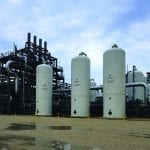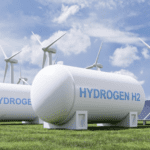Engineering and construction firm McDermott International and pipeline technology developer New Energy Development Co. have wrapped up engineering for two modular 50-MW hydrogen energy projects that they said could enable “grid-scale” hydrogen blending with natural gas pipelines as well as potentially integrate existing or new power plants with energy storage.
The “Green Hydrogen” facilities, which will produce nearly 24,000 kilograms (kg) per day of renewable hydrogen, will “apply to two New Energy customers and two projects,” Scott Shields, a partner at Katy, Texas–headquartered New Energy told POWER. However, Shields declined to disclose the names of its customers or project locations, noting, “at this time, our clients have not released authorization” of those details.
Details about the facilities, including what proprietary components they will include, how they will function, and when they could begin operating, are also murky. In a statement, McDermott and New Energy said the hydrogen design “is ideal for grid-scale blending with natural gas pipelines, blending existing or new power generating facilities and energy storage injection into salt caverns and above ground storage tanks.” Additionally, it “allows for incremental 15 MW of 100% hydrogen-fueled power generation to support grid-scale energy storage applications,” they said.
As Shields explained, in its current configuration, the design offers application optionality. “Green Hydrogen will be able to be injected into turbines, gas pipelines, or power sold into the power markets,” he said. The facilities will leverage a proprietary New Energy design to “power a series of electrolyzers” to produce renewable hydrogen and oxygen. The design, which provides the “flexibility to incrementally expand production and storage capabilities through modular additions,” will “be applied to other upcoming projects and as noted, are expandable to larger (and smaller) applications,” he said.

However, the designs may also leverage other proprietary New Energy technology, such as for waste-energy recovery, which could reshape their economics, Shields suggested. “We can state that New Energy technology and applications significantly decrease the typical cost of green hydrogen production below costs which are typically published,” he said. “For example, deploying pipeline energy recovery applications (on which New Energy has established patents and a history of success) clients can reduce [polymer electrolyte membrane (PEM)] electrolysis power input costs to as low as $0,” he said.
In certain applications, reduced PEM power input costs could put the cost of hydrogen production in a range between $1.37/kg to $2.30/kg, depending on the plant size, Shields said. “This cost equates to below $10 per dekatherm (a typical cost of retail natural gas) to around a third the cost of traditional renewable natural gas (RNG), and possibly on par with the cost of traditional grey hydrogen,” he added.
New Energy is in parallel developing several applications with clients that “address heat recovery on turbines, hydrogen blending on turbines, and even carbon capture from turbines,” he said.
On its website, New Energy suggests the facility design was developed in response to the multi-pronged challenges that pit a heightened demand for progress on carbon neutrality against surging demand for peaking energy.
Recognizing a long list of recent natural gas pipeline project cancelations and stalls, the company’s focus for now rests on non-pipeline technology alternatives and pipeline energy recovery (PER) applications that involve renewable hydrogen and renewable liquefied natural gas, as well as compression and heat recovery and energy storage applications.
Founded on a pool structure to diversify risk, New Energy’s business model is to essentially assess, develop, finance, and own projects in a pool with an assortment of niche business partners. These include firms operating in the midstream, operations and maintenance, and engineering, procurement, and construction (EPC), management, and environmental spaces. New Energy then offers the projects to a variety of offtakers, such as midstream companies, industrial firms, municipalities, local distribution companies, and independent power producers.
New Energy is currently in a “strategic partnership with McDermott’s CB&I Storage Solutions whereby CB&I Storage Solutions provides New Energy, as its customer, EPC services, as well as performance guarantees and other important world-class services,” Shields said. “This invaluable partnership enables New Energy clients unparalleled service and schedule reliability, based upon New Energy’s decades of applicable industry experience” through its owners/partners, he said.
CB&I Storage Solutions also expressed optimism about the facility design and its prospects. “The engineering ingenuity of this design became a reality through the collaboration of many skilled and talented individuals across our two companies,” Cesar Canals, CB&I Storage Solutions senior vice president, said in a statement. “Companies all over the world are looking for tangible solutions to reduce their carbon footprint and this design provides a valuable hydrogen solution to accomplish that goal.”
—Sonal Patel is a POWER senior associate editor (@sonalcpatel, @POWERmagazine).










